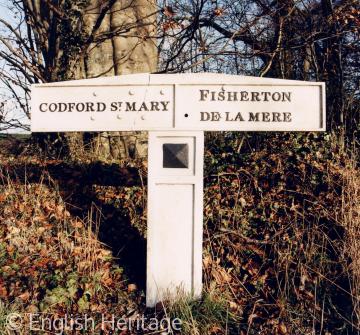Roads
 A milepost on the Wylye Valley Road, which was turnpiked in 1761
A milepost on the Wylye Valley Road, which was turnpiked in 1761From the 16th century there was an increasing desire to improve routes. An Act of Parliament of 1555 required parishes to repair routeways and adult males to undertake four days’ work per year, supervised by elected surveyors. The Act was amended in 1563 and 1575 (repealed 1835). One especially problematic route, or ‘road’ (to use an increasingly used term), was the Great North Road from London to Berwick. From the 1620s complaints were made about the section north of London. In 1663 Parliament finally authorised the establishment of turnpikes (toll gates) for the levying of money to fund improvements between Wadesmill and Royston (Herts.). From 1706 onwards trusts were formed to maintain roads, especially in periods of ‘turnpike mania’, viz. 1751—72 and the 1790s. They were mainly concerned with the more important routes. Until the later 18th century trusts mainly repaired or widened roads, but then and in the early 19th century new construction techniques were developed and widely adopted. The key innovators were John Metcalf (1717—1810), Thomas Telford (1757—1834), and John McAdam (1756—1836). McAdam’s techniques produced well-drained roads at relatively cheap prices. He and his family were influential. Trusts were damaged by the spread of railways from the 1840s and many were dissolved in the 1870s—80s. In 1888 county councils were given responsibility for the maintenance of designated main roads.
From the 1730s local road patterns across an extensive area of England were altered through the inclosure of open fields by Acts of Parliament. Inclosure reorganized the landscape into individual compact farms which required new road layouts. Landowners also often saw inclosure as an opportunity to improve the quality and efficiency of roads within parishes. Inclosure commissioners were given powers to remove or replace existing routes and to create new ones. Earlier inclosures tended to preserve many existing routes, but later inclosures, from the later 18th century onwards, usually created radically different road patterns. Commissioners usually created different types of road for different traffic (e.g. livestock, waggons), but their new main roads tended to be broad with wide verges for the passage of livestock. The parliamentary inclosure movement affected mainly the central area of England in which open fields had been created in the Anglo-Saxon period. It had largely run its course by 1840.
The advent of petrol-fuelled motor vehicles – motorcars, haulage vehicles, buses, and motorbikes – from the 1890s placed new demands on roads. By 1914 there were 132,000 cars and 82,000 goods vehicles in Britain. Road construction and road patterns were affected dramatically. The new vehicles damaged road surfaces; so by 1910 road surfaces were being sealed with tar (or ‘Tarmac’, named after McAdam) to improve durability and reduce dust. The spread of Tarmacking involved decisions about which roads were suitable for the new vehicles. As a result some local roads were left unimproved and continued merely as bridleways. As road traffic continued to increase after the Great War, better roads and new types of roads were required. A Ministry of Transport was created in 1919, and during the 1920s—30s the first bypasses and dual carriageways were built. The 1936 Trunk Roads Act signalled a move to create efficient long-distance motor routes. But little was done until after the Second World War when central government assumed responsibility for the maintenance of main roads. The outstanding development of the late 20th century was the construction of a network of multi-lane motorways, reserved for motor vehicles. Work began in 1956 and the first section – part of the M6 near Preston (Lancs.) – was opened in 1958. By the end of the 20th century there were 2,100 miles of motorways in Britain.
Robert Peberdy





